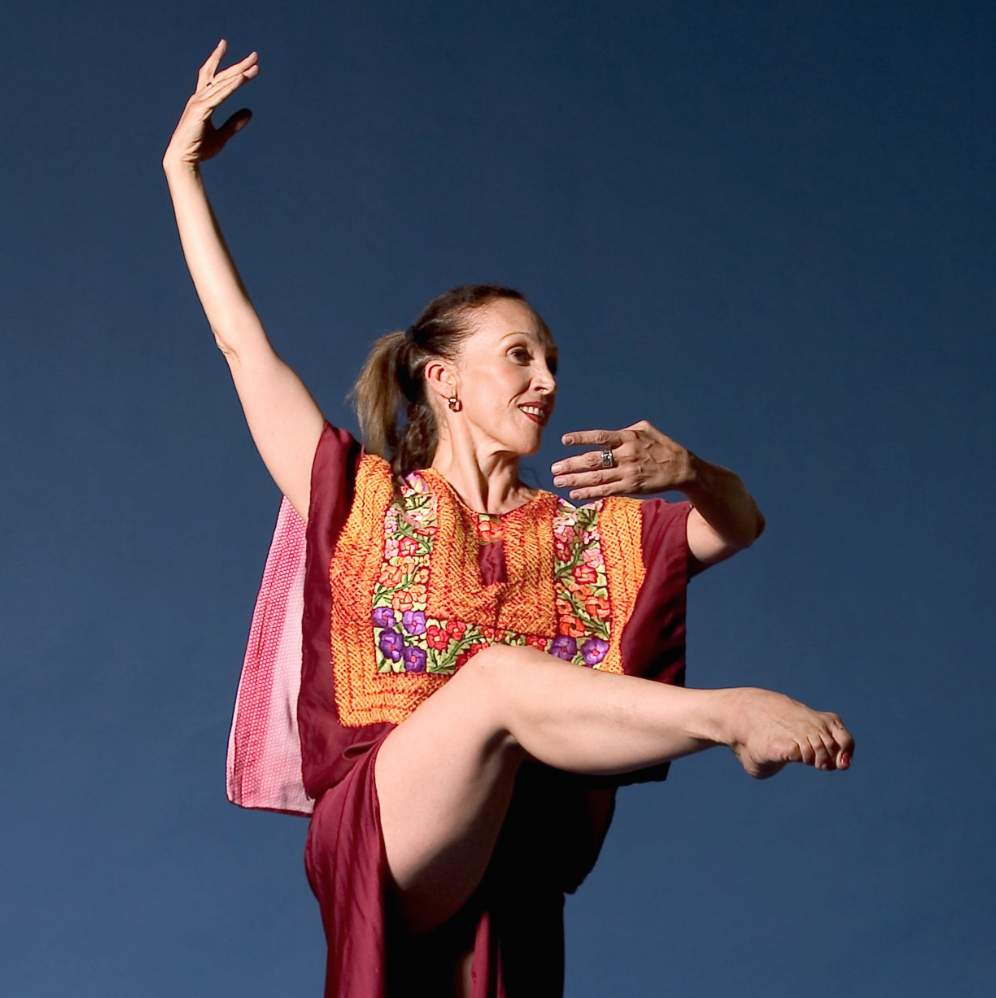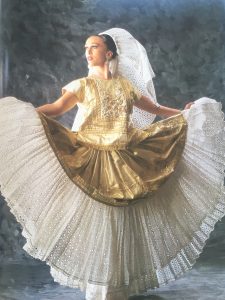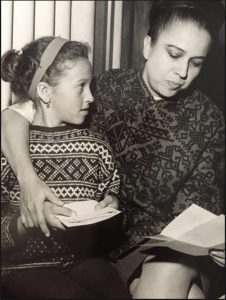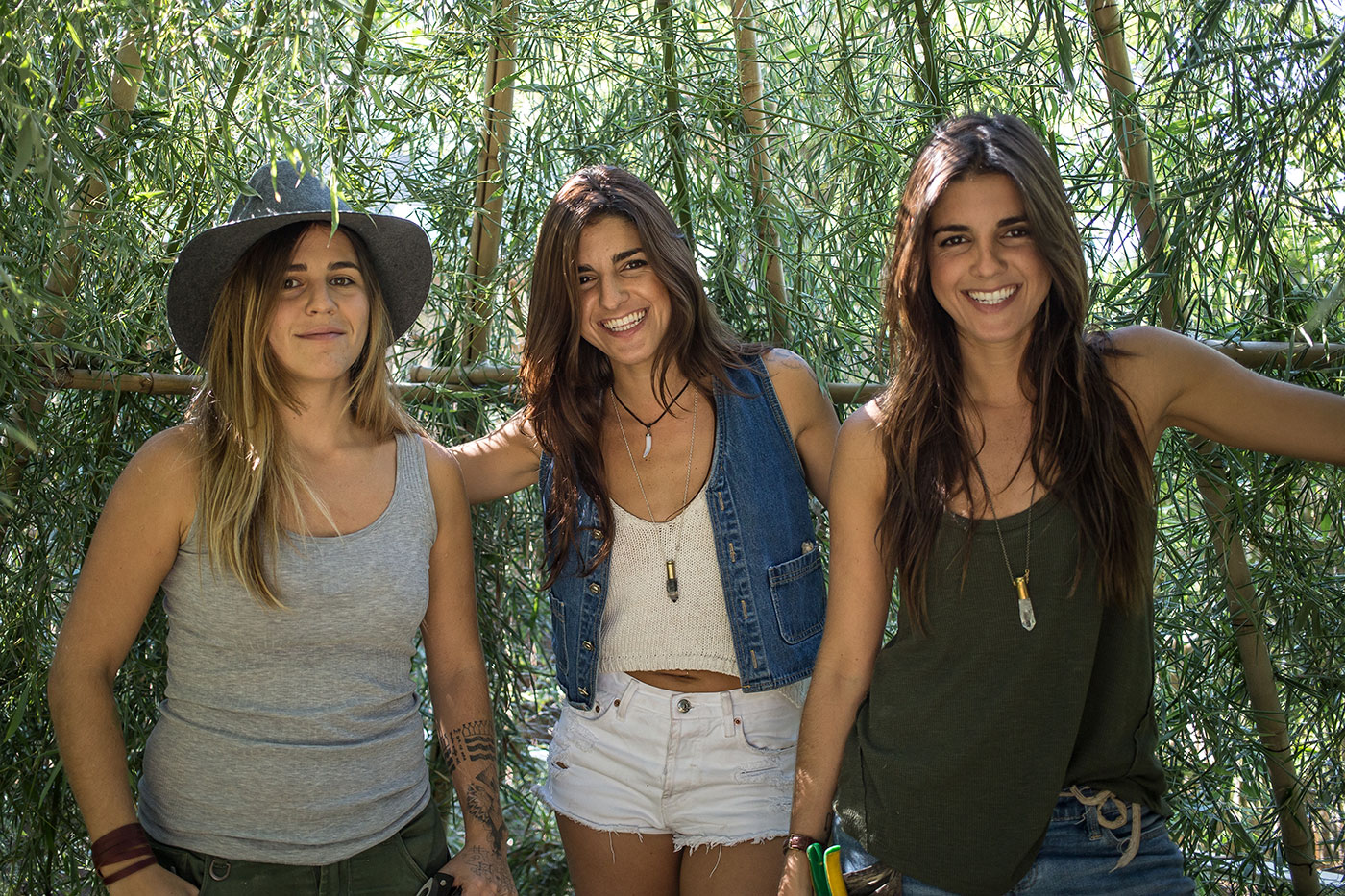Amalia Viviana B. Hernandez

UNA OLA DE AMOR POR MÉXICO
Por Lilia Davis
Bailarina, Coreógrafa y Directora Artística del Ballet Folklórico de México fundado por su mamá, la Sra. Amalia Hernández, nos platica de su pasión por su nuevo legado de danza, México en Movimiento, y expresa por qué no es fácil ser hija de quien es, por qué la China Poblana no es de Puebla, y por qué uno se siente bien bailando.
Viviana acababa de llegar de la Ciudad de México. “¿Comes pan?” fue lo primero que me preguntó al sentarme a su mesa en el restaurante Cheesecake Factory, en Austin, junto con Elissa Fulks, directora general del Ballet de México de Amalia V.B. Hernández en Estados Unidos y Europa. “Te recomiendo este pan artesano con aguacate fresco, tomate, berro, y aceite de oliva con limón, está delicioso.” Viviana te hace sentir bienvenida al instante. Charlar con ella es como abrir una biblioteca de cultura con texturas y colores vivos; sus ojos brillan al hablar con un gran amor sobre la danza y México.
Viviana es la única que lleva el nombre de su mamá: Amalia Viviana Basanta Hernández. Dice que ha estado en la danza prácticamente desde que estaba en el vientre de su mamá. Desde muy temprana edad se formó en varias escuelas de danza: ballet clásico, con la maestra Nellie Happee; ballet contemporáneo, con Guillermina Bravo; el Ballet Nacional de México y en el extranjero por Alvin Nikolai, Murray Louis, Hanya Holm y Alvin Alley. También practicaba con su mamá y los legendarios Martha Graham y Rudolf Nureyev en Nueva York.
¿Ha sido fácil ser hija de Amalia Hernández?
Durante más de 20 años bailé con el Ballet Folklórico de México de Amalia Hernández, pero siempre quise hacer algo propio porque necesitaba mi propio lenguaje, por eso he creado México en Movimiento y ahora el Ballet de México de Amalia V.B Hernández/ ACADEZ en E.U. No es fácil ser hija de quien soy; es una gran responsabilidad, pero también es una inspiración inmensa. El trabajo de mi mamá nos enaltece en todo el mundo.
¿México en Movimiento es ballet folklórico?
No, pero es México. Es algo muy “yo”. Para mí es tomar las partes que no puede agarrar el folklor e introducirlos en un lenguaje contemporáneo con nuevos elementos, con raíces y líneas corporales, que no deja de usar también elementos tradicionales y populares, con lenguajes muy mexicanos desde faldeos, sombrereo y movimientos de pañuelos. Tengo una coreografía que se llama Fandango en Rojo porque se usa una cantidad de faldeo, dando así otro lenguaje.
¿Cuál es tu intención entonces con el Nuevo Ballet de México de Amalia V.B. Hernández en E.U.?
Continuar nuestro legado en E.U. con un toque de modernidad y darles oportunidad a niños y jóvenes bailarines de ser parte de él, para conectar con su herencia e identidad, que de repente desaparece o se desconoce al inmigrar a otro país. Es importante poder transmitir nuestro amor y orgullo de México donde quiera que nos encontremos.
¿Qué fue lo esencial que aprendiste de tu mamá?
Su entrega, su disciplina y que no puedes dirigir sin el ejemplo. Me inculcó un profundo amor por México. Antes de montar una coreografía, mi mamá viajaba en autobús por la región; se fijaba en el baile físicamente, se basaba en cuentos, leyendas y mitos de la narrativa mexicana. Adoptaba los colores de los textiles, comía su comida, lo absorbía todo. Ella era una combinación de maestra increíble, con atributos de un general de división; nos traía marchando a todos con disciplina siempre, ¡Firmeees, Ya! (risas). Nació en la Ciudad de México un 19 de septiembre de 1917. Este año todo México celebra su Centenario.
Cuando bailas, ¿Qué recuerdas más de ella?
Cuando ya no podía bailar, tocaba la puerta de mi recámara, para despertarme y me decía: “Viviana, levántate y ven a bailar este paso, que acabo de componer.” Su mente estaba siempre activa y en función del ballet. Podría faltar a la escuela, pero jamás a una clase de música o ballet.
¿Han surgido algunos bailables regionales nuevos?
Para que una danza se convierta en folclórica, tiene que ser uso y costumbre de la región por lo menos durante 50 años. Por ejemplo, mi mamá compuso el bailable de la polka norteña “La Picota”, porque no existía antes. Hay bailables nuevos, como la danza de Baja California llamada “Calabaceado”, que me gusta mucho.

¿Cómo se construye una coreografía?
Primero se concibe la idea y se investigan sus antecedentes; historia, tradición, leyenda, su carácter festivo o religioso, compenetrarse en las emociones, ver que el análisis musical sea coherente con el lenguaje y que el vestuario simbolice el significado de la danza y la región que representa. Hemos llegado a transportar de 6 a 8 toneladas de baúles de vestuarios por barco para una presentación. El público no ve todo este trabajo, pero cuando estos elementos están bien sincronizados ofrecen un espectáculo inolvidable.
¿Cuál fue tu primera coreografía y cuál te gusta más?
El danzón número 2, bajo la dirección de Arturo Márquez, fue la primera coreografía mía en Palacio de Bellas Artes. ¡Este danzón es mi pasión! También me gusta mucho dirigir el Guapango de Juan Pablo Moncayo. Aunque esta coreografía es de mi mamá, la fui fusionando con algo distinto y contemporáneo.
¿Cuál es el origen del traje de la China Poblana?
Catarina de San Juan, fue su nombre, pero no era ni china, ni poblana, ¡era de la India! La leyenda dice que fue una princesa raptada por piratas y comprada por españoles al llegar a Puebla. Vestía de manera peculiar, con lentejuelas rojas, adornos llamativos y las mujeres de esa época en México adoptaron el vestuario. Los colores verde, blanco y rojo en el traje se comenzaron a utilizar después de la independencia y se ha convertido en un símbolo de México. Nos contaba mi mamá que si usabas zapatos rojos o verdes, expresabas de qué partido político eras partidaria.
¿Cuál es el futuro del Ballet Folklórico?
Para mí es fundamental que el Ballet siga siendo el Embajador de México en el Mundo. Hoy México necesita un lenguaje positivo, nuevo, representando a un país rico en tradiciones vivas. La danza folklórica seguirá, pero va evolucionando lentamente, como todo en la vida. Nuestro legado representa el pasado, el presente y el futuro al mismo tiempo, puesto que en México tenemos una fusión de tradiciones africanas, árabes, gitanas, españolas, y europeas en general.
¿Qué te hace feliz?
Transmitir este legado de danza a las generaciones de mexicanos en otras partes del mundo. Soy feliz porque estoy en el momento presente. Uno se siente bien bailando.
Te invitamos a ser parte del Ballet de México de Amalia V.B. Hernández en Estados Unidos con sede en Austin, Texas. Para mayor información visita: www.balletmx.com
A DANCER WITH NEW STEPS
Dancer and choreographer, artistic director of The Mexican Folkloric Ballet, youngest daughter of the famous internationally known and founder of the Mexican Folkloric Ballet, talks to us about her new project, México en Movimiento, describes the bumps in the road arising for the daughter of a noted mother; explains why the China Poblana is not from China, and how good she feels when dancing.
Viviana had just arrived from Mexico City that afternoon. The first thing she said to me as I joined her for lunch at the Cheesecake Factory in Austin, along with Elissa Fulks, current director of Ballet de México de Amalia V.B. Hernández in the United States and Europe: “Do you eat bread?” “This artisan bread with fresh avocado, tomatoes, watercress, olive oil and lemon is delicious.” Viviana makes you feel welcome from the minute you meet her. Talking to her is like opening a cultural library of lively colors and textures, – her bright green eyes begin to shine when with a huge passion and love, discusses dance and México.
Viviana is the only daughter that carries her mother’s name: Amalia Viviana Basanta Hernández. She received an education in dance at a very early age, studying and rehearsing with legendary teachers in Mexico such as: classical ballet with Nellie Happee; contemporary ballet with Guillermina Bravo; National Folkloric Ballet, and foreign professors such as Alvin Nikolai, Murray Louis, Hanya Holm and Alvin Alley. She also studied with her mother, Martha Graham and Rudolf Nureyev in New York.
Has it been easy to be the daughter of Amalia Hernández?
For more than 20 years, I danced with the Mexican Folkloric Ballet of my mother. Nevertheless I felt that I needed my own language, something within the precincts of contemporary dance, so I created a dance project called Mexico in Movement and recently the Ballet de México de Amalia V.B Hernández/ ACADEZ in United States. It is not easy to be the daughter of a mother like mine, it’s a great responsibility, but also an immense inspiration.
But is México en Movimiento a folkloric dance?
It involves taking some parts within the folkloric dance and introducing new elements with a contemporary language and new roots and body lines, but using traditional elements, such as skirt movements, and handkerchiefs movements. I have a choreography called “Fandango Rojo” because it uses lots of skirt movement, thus providing another language.

¿What is the purpose of the New Ballet de México de Amalia V.B. Hernández in USA?
To continue this legacy of Ballet Folklórico in the United States, with a touch of modernity, in order to give an opportunity to children and young dancers to become part of it. Most importantly to connect them with their Hispanic heritage that often disappears when you immigrate.
What did you learn from your mother that is most essential?
Discipline and dedication, and that you cannot lead without an example. She instilled in me a deep love for México. She always travelled by bus to the region before she even started a new choreography. She studied the physicality of the dance, but also took into account the stories, legends and myths of the Mexican narrative. She adopted all the local textile colors, ate the food, she absorbed it all! She was an incredible teacher, combined with the character of a Major General. She always kept us on the march, “Firmes, Ya!” (Stand at attention, now!) (laughter). Born on September 19, 1917, her 100 year anniversary is being celebrated all year in Mexico.
How do you remember her when you dance?
When she could no longer dance, she used to knock on my door, wake me up and tell me: “Viviana, wake up, and come and dance this step that I have just composed.” Her mind was always active, and in function with ballet. I could skip a day in school, but I could never skip my music or ballet classes
Have new regional dances emerged in Mexico?
A dance has to be part of the customs in the region for at least 50 years. We have 32 states represented so far, but there are new dances such as the “Calabaceado” in Baja California. I like it very much.
How is a choreography composed?
You have to have an idea first and then research its background rigorously; history, tradition, time, its religious or festive character, and its internal and emotional meaning. The music and costumes have to symbolize the meaning of the dance of the region of Mexico it represents. The public does not see all this work, but when all these elements are well synchronized they render an unforgettable display of choreography.
Which was your first choreography and which is your favorite?
Danzón No. 2 under the direction of Arturo Márquez, was my first choreography in the Palacio of Bellas Artes in México. That dance is my passion! I also very much enjoy directing the Huapango de Juan Pablo Moncayo. Although this choreography is by my mother, I fuse it with something different and contemporary.
Where was the woman named China Poblana from, and why did her dress become a symbol of Mexico?
She was not from Puebla, nor from China, but she was from India! The myth says that she was a princess kidnapped by pirates and purchased by Spaniards upon her arrival in Puebla. She was dressed in a very peculiar way with red sequins, eye-catching accessories and the women adopted it as a Mexican outfit. The red, white and green colors in the dress were used representing Independence and has become a symbol of México. My mother used to say that the color of your shoes, red or green, would declare the political party you supported.
What is the future of the Folkloric Ballet?
To me it is fundamental that the Ballet continues being the Ambassador for Mexico around the world. Nowadays Mexico needs a positive language, a country rich in traditions that are still alive. Folkloric dance will continue, but it is undergoing a slow evolution. It represents the past, present and the future at the same time because in Mexico we have a fusion of African, Arabic, Gypsy, Spanish and European traditions in general.
What makes you happy?
Preserving this legacy of dance for other generations of Mexicans everywhere. I am happy because I am living in the present moment. One feels good when dancing.
You can be part of this incredible ballet in the United States, please contact Ballet de México de Amalia V.B. Hernández en Estados Unidos in Austin, Texas, at www.balletdemexicoenusa.com

